We did start the Fire: Sivakasi’s fireworks industry
ANURAG MALLICK & PRIYA GANAPATHY visit Tamil Nadu’s legendary Pyro Town Sivakasi (Kutty Japan) to see how fireworks are made and why a tiny village became the largest firecracker hub in India
From : https://redscarabtravelandmedia.wordpress.com/tag/kutty-japan/
The distinct smell of crackers clings to the night air as we drive in. ‘Welcome to Pyro Town’, proclaims a wayside board. We are in gandhaka bhoomi or the sulphurous land of Sivakasi, which accounts for 90% of India’s total fireworks production, 80% of all safety matches and 60% of total offset printing solutions. In a roadside shop, the list of luminaries on the fireworks boxes is mind-boggling. In remote Sivakasi, blissfully unaware of copyright infringements, everyone from Asin, Britney Spears, Marilyn Monroe, Harry Potter, Superman, Spiderman and WWF wrestlers hawk the wares. Baby bump or not, Aishwarya Rai was still the universal favourite.
Around the same time, Sivakasi was reeling under drought and famine, forcing two enterprising cousins, A Shanmuga Nadar and P Ayya Nadar, to head for Calcutta in search of better prospects. There, they stumbled upon the Japanese match factory next to their lodge. After learning the craft for eight months, they returned to Sivakasi and established a factory with raw material and machines imported from Germany. When mechanized production proved costly, they adopted Gandhiji’s swadeshi mantra and call for cottage industries. The brothers switched to manual production using cheap local labour and set up individual factories in 1926 – Kaka Match Industries and Anil Match Factory, with crow and squirrel as their symbols.
In those days, plain phosphorus sticks were used to strike a light and Swedish Match had just established WIMCO (Western India Match Company). Through experiments and books on chemistry, the brothers developed safety matches and colour matches, which were being imported from Europe and Asia. In due course, other entrepreneurs applied match-making techniques to produce fireworks, thereby triggering the birth of a second industry. Since labels were sourced from Mumbai and Chennai, KSA Arunagiri Nadar established a litho-printing unit in Sivakasi in the 30s. The introduction of offset was the genesis of a third industry.
Sivakasi had a clear advantage over other places. Its all-year-round dry and sunny weather made it ideal for these industries to flourish. Damp weather and moisture not only affected the crucial drying process of fireworks, but also crinkled the paper, making it difficult for printing. Today Sivakasi has a matches, firework or printing unit in every nook and corner, thus earning the sobriquet Kutty (Little) Japan. Little do people know that Sivakasi also provides customized solutions like practice bombs, smoke screens, powders and fuses to the Indian Army and its Ammunition and Ordnance factories. The local fireworks industry is estimated to be Rs.2,000-3,000 crore. But it was a chain of unconnected events that led to Sivakasi’s rise as India’s fireworks capital.
When a Central Excise Duty was levied on matches in 1934, people diverted their energies towards fireworks. Until the outbreak of World War II in 1939, there were only a few units in Sivakasi, but the obstruction of firework imports during wartime boosted the indigenous industry. In 1940, the Indian Explosives Rule introduced a new system of licensing for the manufacture, possession and sale of fireworks, paving the way for the first organized factory. By 1942, other companies like National, Kaliswari and Standard Fireworks set up shop. With the end of World War II in 1944, the renewed import of raw materials helped expand the market. People who worked under the two Nadar brothers – be it a typist, worker or accountant – eventually set up their own units with their blessings.
Mr. Arumugaselvan elaborates ‘Kaliswari, one of Sivakasi’s oldest companies, was started by A Shanmuga Nadar with the famous Cock brand. The first bomb produced at Sivakasi was the ‘Atom bomb’ and everything evolved slowly through trial and error. Now R&D has come in and major companies have pyrotechnicians or chemical experts and permanent mixers. In smaller factories, an outsourced person visits between 8-10 am to prepare the chemical mix while others do the filling and packaging. A person may join as a clerk, move to a desk job, graduate to a computer and if he has the aptitude, go on to handle sales. Though people have stuck to the industry for long, the loyalty factor has changed. Earlier, if someone had three children, all would join the fireworks industry. Now, two go out for better opportunities, while the one who looks after the parents, joins the industry.’
‘Earlier, usage was centered only around Diwali, but now it has spread to other festivals like Holi, Dussehra and occasions like marriages, birthdays, deaths, new year’s, events, politics and cricket. The overall hike in usage has led to a year-round season catering mainly to the domestic market. With enough local demand, there’s no fear of globalization,’ he quips. ‘Though China and Italy are world leaders in fireworks with a machinery-driven approach, India is labour-intensive. If a worker has small palms and another has bigger palms, the way they roll the explosive will be different. How a pinch of salt affects the flavour of food, the manual nature of the job affects the colour, sound and bursting capacity of the explosive. This manual element has been eliminated in overseas industries. People prefer the precision of machines and have specific demands. Every bomb or cracker promises certain intensity or duration; if an aerial display is supposed to last 10 minutes, people expect 10 minutes.’
‘Consumption patterns are different too. Abroad, people don’t burst crackers individually, but witness community firework displays held over bay areas. It’s a spectator sport. But in India, it is participative. The average guy wants more bang for his buck. Only if there’s a loud noise, there’s mazaa in it. In comparison, a cracker emits less sound than a train or flight. During Diwali, it’s winter in North India. Due to the thick mist, the smoke from fireworks gets trapped, so pollution charges levied against us are exaggerated. However, we’re trying to address both issues of noise and air pollution. Of course, it’s a risky industry. Over the years errors have come down drastically. But a small slip from unlicensed units is enough for the media to raise a hue and cry about the whole industry. If you go by the number of road accidents every day, the PWD minister ought to be arrested daily!’
On the challenges and problems faced by the industry, Mr. Arumugaselvan laments, ‘Sadly we don’t have a hub. Restrictions on transportation and explosive rules on shipping and aircrafts have hampered the industry’s growth overseas. There’s no electricity supply in manufacturing units out of fear of a short circuit. Despite 99% literacy in Viruddhnagar, unlicensed set-ups employ uneducated people and their carelessness leads to mishaps. Licenses for up to 12 sheds are granted from Madras, but for more than 12 sheds, one has to go to the central office at Nagpur. Officers from the Explosives Department and Factory Act people come for regular checks.
Often, suspensions are imposed and due to harassment, we lose many days of production, leading to shortages. There’s also a dearth of skilled and unskilled labour. Since all the units in Sivakasi are essentially offshoots of two or three original companies, people are highly egotistic. There’s no co-operative society, hence no representation at the state or central level. That’s our biggest drawback.’
At Lakshmi Agencies, an exclusive showroom for Vinayaga/Sony Fireworks, T Ganeshan is candid, ‘When we started this shop in 2002, we made only Rs.4 lakh in the first year. The demand was only for sparklers, chakras, anars, but the increase in living standards has led to flashier fireworks. Sky outs (colourful designs and explosions in the sky) are in great demand. Today, this little outlet does Rs.80-90 lakh annually. I’ve seen an abnormal growth in the industry. Now, we receive orders from Chennai, Madurai, Tanjore, Nagercoil and Hosur on the phone! Though Standard, Kalishwari and Ayyan are pioneers in Sivakasi, we’ve tied up with China and learnt new things from the West.’
‘Today, Sony Fireworks has a turnover of Rs.70-80 crore and is Number 1 in Sky Outs. Our Rainbow Smoke and Confetti explosions are used in films and Bollywood shows. Each year, new products and designs are introduced based on latest trends. Our young MDs, Mr. Karvanan and Mr. Ganeshan, with strong chemistry and marketing backgrounds, have brought in fresh thinking and new technologies. After KBC caught on, we introduced ‘Magic Show’, with fake Rs.500 and Rs.1000 notes bursting with each explosion. Now that’s called literally blowing up money’, Ganeshan chuckles.
Firework factories are divided into specialized units that manufacture Paper Caps, Ring Caps, Serpent Eggs, Bombs, Rockets, Sparklers or Fancy Items. The compound wall is usually 100 m away for reasons of safety. Due to lack of space inside town, explosives factories have spread across a 20 km radius around Sivakasi – Tiruthangal, Servaikaranbatti, Kumaralingapuram, Vellur, Kavalur, Ammathur, GN Petti, etc. The only company located inside town is Bharat Fireworks started in 1923. But we are off on a factory visit to Standard Fireworks, India’s largest fireworks company, with 47 factories, a fleet of 200 buses, a massive godown, offset printing units and a Mega Store.
At Unit A in Mela Amathur, Manager OP Mummurthy greets us warmly. ‘This unit started two years before I came from Palayamkottai in 1981. It’s hard to imagine this 60-acre patch shaded by neem trees was once an arid, undulating field covered by veli karvalai (scrub)’, he shakes his head. Has anything changed since then, we ask? ‘Earlier, we made small items like sorsa-vedi, kurvi-vedi, bullet-vedi, giant-vedi, lakshmi-pataki, krishna-pataki, tukda, yali; all improvised with gunpowder, newspaper, cardboard and string. But now it’s only fancy items.’
Today, this single unit employs 340 people, of which 280 are women. Women make roughly Rs.100 a day, while men get Rs.150 because of heavier workload. Chemical mixers, who work lesser hours, also make Rs.150 as it’s a high-risk, specialized job. Four buses ply daily and work starts at 8 am. In a mixing shed behind mounted walls, a stipulated amount of masala is prepared, enough to be used in a day, otherwise the chemical decomposes and becomes unstable. With 55 sheds, each having four workers, this unit churns out 26 varieties including sparklers, flowerpots and fancy items. The unit works at a brisk pace to meet its daily target of 250 assorted boxes. Each firework is unique with its own chemical formula and shell.
As per safety guidelines, not more than 25 kg of explosive masala can be prepared at a time. At a drying platform, masala is dried on 3 mm thick rubber mats till noon everyday; doing it directly on the ground poses a danger of explosion. Only brass implements are used as iron may cause combustion. Each worker handling gunpowder and firework mix wears a rubber apron and headscarf for protection. All must customarily wear cotton. Peppered through the premises are sand buckets, water troughs and first aid boxes. Safety showers are installed in case of fire accidents, besides a siren and a wind balloon to indicate the direction of wind. While fire engines are stationed 5 km away, a water tanker is on standby for dousing larger flames.
At the sparkler section, ladies deftly stack and tighten 10½ inch long copper-coated wires in a 17X18 wooden grid. 600 such frames are churned out each day. A human chain passes the frames to and fro as they are dipped into a grey chemical paste, before being sun-dried for an hour, until the next two coats are applied. Some frames are taken to a man seated with a pile of shiny powder who flings magnesium alloy to create the crackling variety. At 2 pm, the sparklers are picked out of the frames and women swiftly pack them into sets of 10, which are further bundled into sets of five. 40 such bundles are put into cardboard cartons, punch-stapled and loaded onto bullock carts for transportation.
In the flowerpot section, women busy churn out ‘Happiness’, a pink-wrapped cylinder that creates a whistling sound. The chemical mixture is spooned into the outer tube – black gunpowder at the bottom to provide lift and colour pellets on top for show. The inner whistling tube is filled with whistling chemical and a wick, and the tube is packed with sawdust. Both ‘Happiness’ and ‘Splendour’, a violet-coloured tube that produces a crackling sound, are manufactured with Chinese technical collaboration.
In the Tower Pot section, large pyramidal flowerpots are being pierced with a brass needle as another worker fixes the wick with black chemical goo. On an outdoor table, a lady pours fasting solution into a bowl of dry powder and gently stirs it as if preparing batter for a brownie. In another shed, ladies pack Mini Fountains in plastic packets like assorted candies. Elsewhere, the deodorant-sized Jade Flower is being packed into cartons of five and three 18” long cylinders are twirled together to create a Magic Tree. A lady supervisor oversees the operations of five sheds and 15 watchmen guard the facility at night.
At 12:30 pm, the gong is struck, announcing lunch. Women slowly pour out of their sheds and unhurriedly clean their hands with industrial soap and coconut oil. With foreman S Kannan in tow, Mr. Mummurthy cajoles the workers as he leads us to the office for tea and biscuits. ‘You have to be strict, yet keep them in good humour. Not only must we look after employees, we also decide on the mix and what has to be made everyday. The chemicals used are more or less the same – Potassium Chlorate, Sodium Nitrate, Barium Nitrate, Strontium Nitrate, Sulphur, PVC Resin, Charcoal, Metal powder and Aluminum powder. But every company has its trade secrets and only years of experience leads to unique mixes. All our raw material comes from sister concerns like MEPCO (Metal Powder Company) at Tiruthangal.
When asked how it feels to be in this industry, Mr. Mumurthy beams, ‘While all my friends work in Government jobs, I am proud to be in this exciting line. The management looks after me well and there’s career growth.’ What about the risks? ‘Every industry has risks. 20 major mishaps have occurred in Sivakasi in the past 10 years and they happen mostly in unlicensed factories and units that flout safety and child labour norms. But all of Sivakasi gets a bad name. A safety officer is permanently stationed on our premises and there’s ESI (Employee State Insurance), PF and medical cover for everybody, besides a monthly health check-up. Due to stringent guidelines, 45 out of Sivakasi’s 600 units were shut down recently and their licenses revoked.’
And what about the bananas? ‘Bananas?’ His eyes follow our gaze to the big clump in the corner. ‘Oh that!’ he laughs uproariously. ‘We give bananas to our employees at lunch time and after the day’s work as it is believed to cleanse all impurities in the system.’ We return to the comfort of Bell Hotel, opened to cater to buyers from North India who would come thrice a year to Sivakasi and find no good place to stay or eat! We meet the Singh brothers, sons of the legendary A Chelladhurai, who started Standard in 1942 with NRK Rajaratnam. ‘Standard has taken strident steps on the global stage. We did a JV with Phoenix in 2001 to set up three units in China and won top honours at an Intercontinental Competition in 2008. Yet, our real achievements lie elsewhere – we provide employment to over 8000 local women and give opportunities to the disabled. Our father considered opening a women’s college in Sivakasi as his greatest achievement.’
As we drive out of town, we notice the number of educational institutions established by fireworks companies. Sivakasi has moved on and good work is being done, but people don’t look beyond the stereotype of child labour. In a fitting goodbye, fireworks light up the night sky. It’s 7 pm and factories were testing the day’s production for defects. We realize in Sivakasi, it’s Diwali everyday…
Authors: Anurag Mallick & Priya Ganapathy. This article appeared as a Diwali special feature in the November, 2011 issue of Rail Bandhu, the Indian Railways’ in-train magazine.

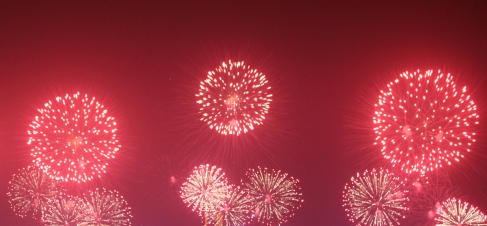
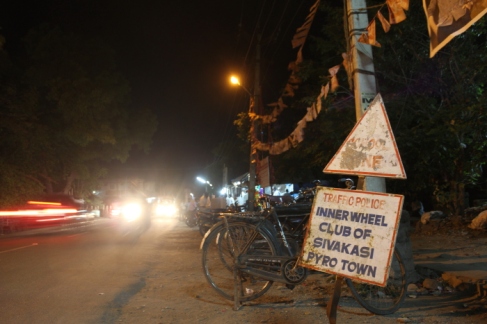



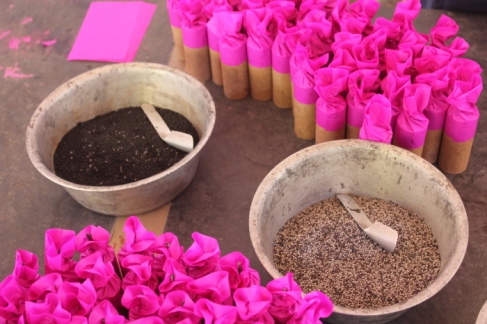
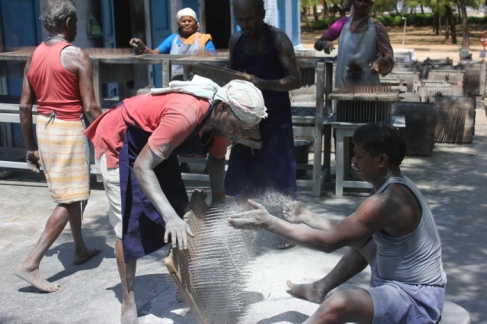
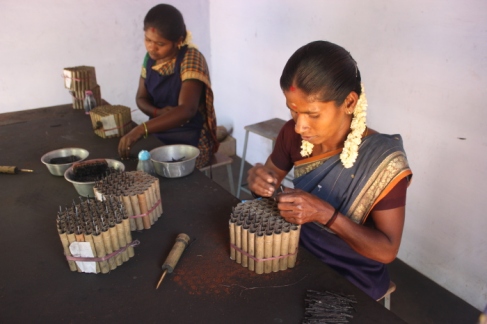

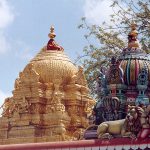

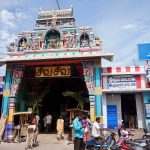
Leave a Reply
You must be logged in to post a comment.